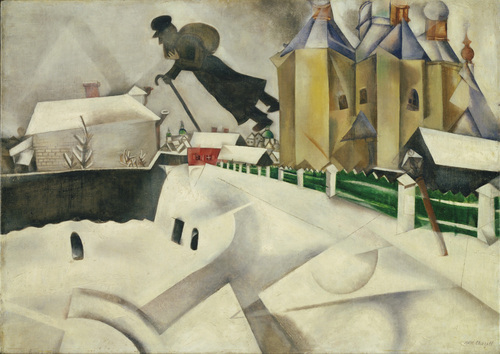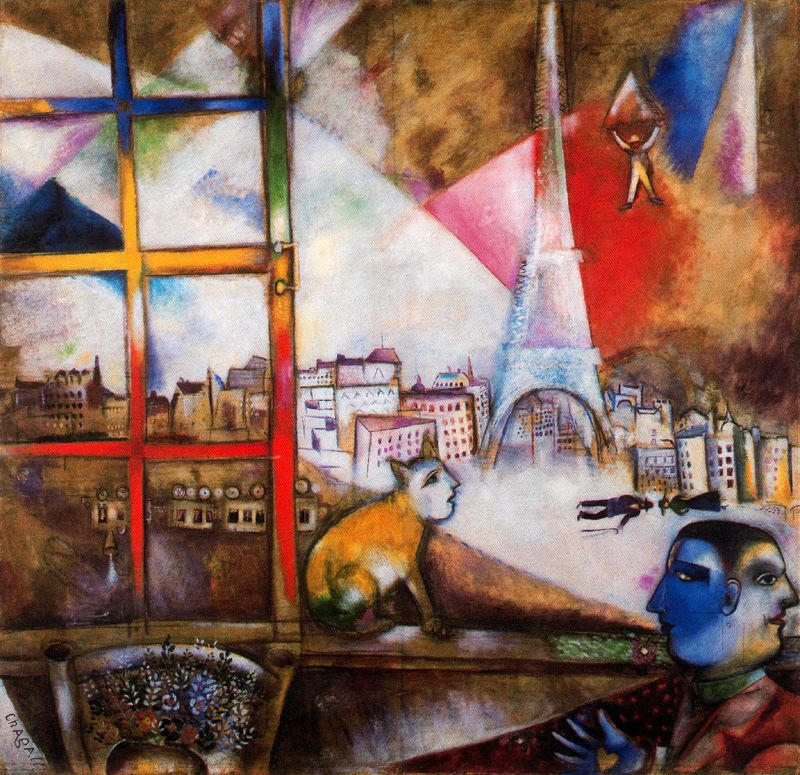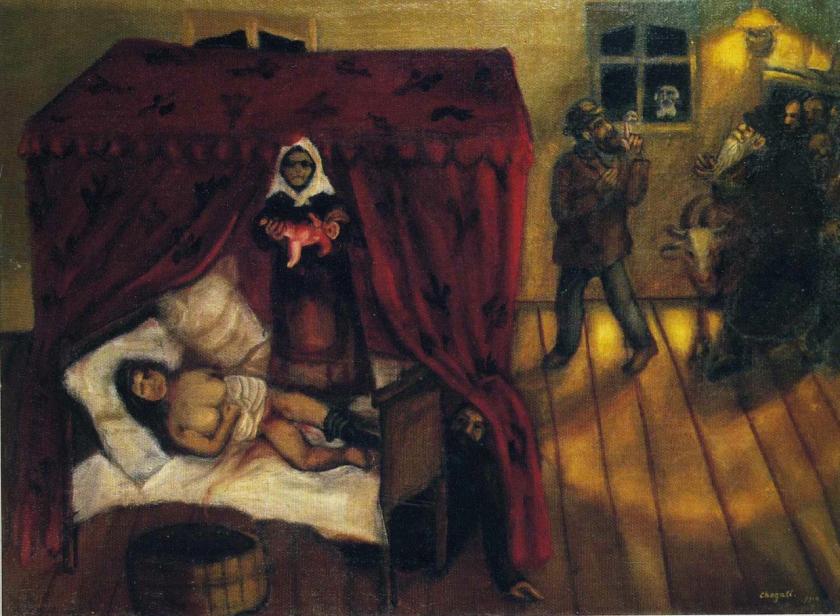“Charming” is undoubtedly a double-edged word. Along with its perfumed allure, it carries a whiff of insincerity, of something slick and not quite earned. Add “whimsical” and you know you’re in danger of saccharine overload. Chagall is both, plus he’s one of the most popular artists of the 20th century. Does it get any worse?
Marc Chagall was born Moyshe Shagal in Vitebsk, a region now in modern-day Belarus with a big Hassidic population. And though he absorbed some of the ideas of Cubism during his three years in Paris as a young man, his paintings are infused with the mystical and the folklorish, in tender homage to his Russian Jewish background: paintings like The Violinist, 1911-14, in which an old Jewish fiddler appears, shaggy-bearded and green-faced, as one of his stock characters, and Over Vitebsk, 1922 (pictured below), in which one of his wandering Jewish peddlers floats above a snow-covered shtetl with a sack slung over his back.
Stage sets are where Chagall excelled as an artist
The exhibition, the first survey in the UK for 15 years ago, focuses on the years between 1911 to 1922, the period of his most intense creativity, though there is one earlier work, Birth, of 1910 (main picture), painted a year before he left for Paris, aged 23. Reminiscent of a crude Mexican votive painting, the dimly lit scene depicts a mother lying naked and exhausted on blood-soiled sheets, having just given birth. A grim-faced midwife holds the bloodied newborn, while the father cowers under the bed, partly hidden by the puce-coloured curtains pulled back as if opening onto a stage set. Pushing through the door and peeping through the window, which looks out onto a black night, are the villagers, accompanied by an ox, and a rabbi. Raw tenderness and slapstick comedy in one scene.
 In fact, stage sets are where Chagall excelled as an artist. He trained under the great set and costume designer Leon Bakst, who worked with Diaghilev’s Ballets Russes, creating bold designs for Stravinsky’s avant-garde music and Fokine’s daring choreography, and it was to work for Diaghilev that Chagall left for Paris in 1911. It was also during this period when he was exposed to Cubism and the Orphism of his friend Robert Delaunay, who infused his fractured forms with soft, expressive colours. He took all this on board not so much as an intellectual investigation of space and form, but as a stylistic device, creating pastoral poetry with his dream-like scenes of floating lovers, boneless figures elegently swaying and bending any which way and creatures with sphinx-like, wisely benign faces.
In fact, stage sets are where Chagall excelled as an artist. He trained under the great set and costume designer Leon Bakst, who worked with Diaghilev’s Ballets Russes, creating bold designs for Stravinsky’s avant-garde music and Fokine’s daring choreography, and it was to work for Diaghilev that Chagall left for Paris in 1911. It was also during this period when he was exposed to Cubism and the Orphism of his friend Robert Delaunay, who infused his fractured forms with soft, expressive colours. He took all this on board not so much as an intellectual investigation of space and form, but as a stylistic device, creating pastoral poetry with his dream-like scenes of floating lovers, boneless figures elegently swaying and bending any which way and creatures with sphinx-like, wisely benign faces.
The centrepiece of the exhibition are the murals Chagall created in 1920 for the Moscow theatre impresario Alexander Granovsky. Five upright panels for the Russian State Jewish Chamber Theatre depict archetypal Jewish characters: the violinist, the marriage broker, the wedding dancer, the Torah scholar and the wedding jester. There is also the eight-metre-long epic The Wedding Feast in which acrobats and musicians, as well as goats and hens, parade across a dynamic rainbow-coloured backdrop of arcing and diagonal forms.
Having found himself stranded in Russia, first by the outbreak of war, then by the Revolution, Chagall flirted briefly with the geometric abstraction favoured by the new Soviet regime, but although his efforts were always uniquely rooted in his Jewish background – one abstract collage has a cut-out with Hebrew lettering printed across it – his heart was clearly never in it. He’d also been appointed commissar of the Vitebsk art school, which had also recruited Malevich and El Lissitzky, though here Chagall found himself so at odds with the prevailing theories of the Soviet avant-garde that he soon resigned his post.
 Two of Chagall’s best-loved works, Paris Through the Window, 1913 (pictured left), from the Guggenheim in New York, and The Promenade, 1917-18, from the State Russian Museum in St Petersburg, are here. The first features that soaring icon of modernity, the Eiffel Tower, glittering against a vista of blushing pinks and sunny yellows, while a nonchalant human-faced cat stares up at a parachuting figure in the sky. The second shows two lovers, a self-portrait with the artist's future wife Bella - in which Chagall presents himself as a hearty, beaming fellow solidly anchored by gravity, while Bella floats above him like a billowing kite, her hand firmly clasping his. The village spreads out around them like a lustrous miniature toy town.
Two of Chagall’s best-loved works, Paris Through the Window, 1913 (pictured left), from the Guggenheim in New York, and The Promenade, 1917-18, from the State Russian Museum in St Petersburg, are here. The first features that soaring icon of modernity, the Eiffel Tower, glittering against a vista of blushing pinks and sunny yellows, while a nonchalant human-faced cat stares up at a parachuting figure in the sky. The second shows two lovers, a self-portrait with the artist's future wife Bella - in which Chagall presents himself as a hearty, beaming fellow solidly anchored by gravity, while Bella floats above him like a billowing kite, her hand firmly clasping his. The village spreads out around them like a lustrous miniature toy town.
Chagall’s sugar-coated sentimentality is a default tendency, and when he moves away from it, for instance in the glowering Jew in Red, 1915, it feels just a little forced. His later works, post-1922, of which we get a only a small taste, shows that he’d already achieved his most powerful compositions in those short years in Paris and then in the few years just before and after the Russian Revolution. The exhibition ends with Mauve Nude, 1967. This might lack something of the simplicity and directness of the earlier work, but the colours still sing out.









![SEX MONEY RACE RELIGION [2016] by Gilbert and George. Installation shot of Gilbert & George 21ST CENTURY PICTURES Hayward Gallery](/sites/default/files/styles/thumbnail_125_x_125_/public/mastimages/Gilbert%20%26%20George_%2021ST%20CENTURY%20PICTURES.%20SEX%20MONEY%20RACE%20RELIGION%20%5B2016%5D.%20Photo_%20Mark%20Blower.%20Courtesy%20of%20the%20Gilbert%20%26%20George%20and%20the%20Hayward%20Gallery._0.jpg?itok=3oW-Y84i)





Add comment